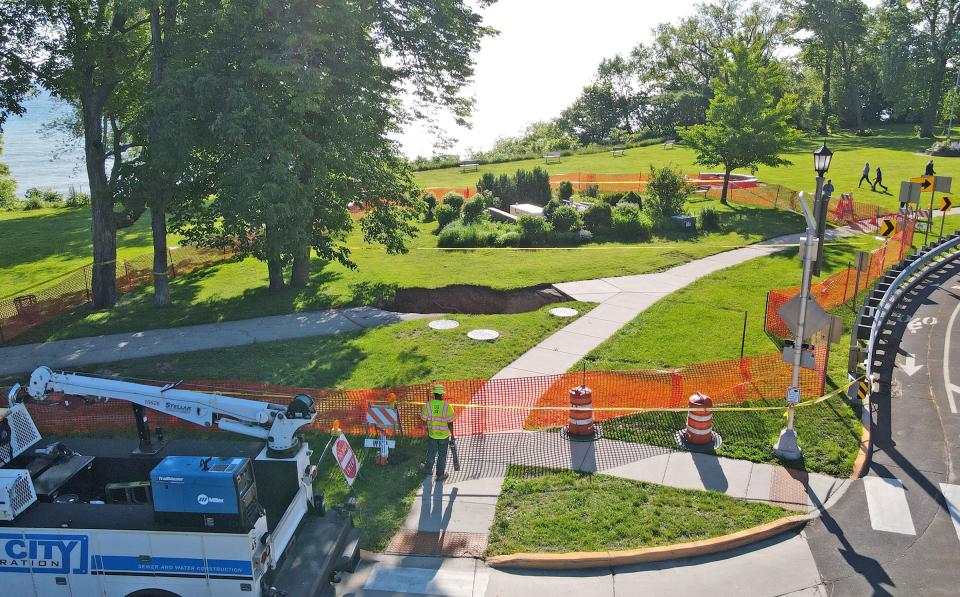Whitefish Bay works to fix sinkhole, warns that aging utilities are widespread
As Whitefish Bay works to fix the collapsed 90-year-old utility pipe that left a gaping sinkhole around Big Bay and Buckley Parks, village staff warn that aging utility infrastructure could be a much more widespread issue.
Both parks remain closed to the public, but in the weeks since the collapse on June 9 and the Public Works Committee's declaration of a Public Works Emergency days later, the village has worked to install 500 feet of temporary outfall piping that snakes from the collapsed pipe down to Lake Michigan and reduces flooding risks, Department of Public Works Director Matt Collins said.
Additionally, engineers with the village's DPW installed sensors to monitor flood risk during heavy rainfall, which will enable them to pump storm water into bypass locations.
The short-term mitigation measures reduce the immediate flooding risk within the village, but Collins cautioned that "the village isn't out of the woods yet."
A major storm event could still impact public and private property, Collins said in a July 1 memo to the village board.
"Although I'm happy as far as how we were able to expedite the temporary repairs, it's still going to be a long road for us to do the permanent stuff, and we just don't want to take our foot off the gas pedal, he told the Village Board during a July 1 meeting.
At the meeting, Collins updated the board on these emergency risk management measures and pivoted towards more permanent repairs.
The board ultimately approved a "direct design build," meaning they'll hire a designer and contractor without taking public bids the way public works capital projects are traditionally done.
This will expedite the permanent repair process, so that it will take between six to eight months instead of upwards of a year, Collins said.
There is no estimate yet on how much permanent repairs will cost, but temporary repairs have already topped $500,000.
Aging utility infrastructure is a widespread issue and village staff are looking toward the future
In an interview with the Journal Sentinel, Collins looked even further down the road. Asked how many of the village's other utilities might also be 90 years old, he said he assumes "it was all constructed in the same era."
He said examining the rest of the village's utility infrastructure is a task village engineers are looking toward in the long term once they effectively manage the consequences of the sinkhole.
Collins also said aging utility infrastructure is something many municipalities in Wisconsin ― and even across the country ― are going to have to grapple with in the coming years.
"A lot of older municipalities were built in the early 1900s era, leaving infrastructure that's close to 100 years old in some cases," he said.
"There is a sense of urgency over these utilities that did stand the test of time but not in perpetuity. There is a shelf life as those utilities age, and a lot of people don't see what's 70 feet below their feet until it becomes too late."
He said this entire sinkhole incident should be eye opening, not just for the village but the entire region.
"If we don't manage these things, we're going to continue to see that happen," he said. "I want to be as proactive as possible within the village here from here on out."
The city of Franklin recently repaired a large sinkhole on West Puetz Road.

A closer look at the emergency repairs in Whitefish Bay
The village’s storm water utility is divided into seven watersheds through a network of underground storm sewers and manholes that capture and drain runoff in the watershed.
The sinkhole was caused by the collapse of a storm water utility outfall pipe, part of the village's primary storm water conveyance, 70 feet below the surface of Buckley and Big Bay Parks.
Since there is only one outfall per watershed, the storm water within this watershed was not able to drain as designed and prevented runoff from discharging into Lake Michigan.
This failure created an immediate emergency for the village, risking flooded streets, sanitary sewer failures, We Energies gas utility issues, basement backups, continued sinkholes, erosion or bluff destabilization, and the potential loss of the sanitary sewer lift pump generator, Collins said in the memo.
As a result, the emergency response involved installing 500 feet of 36-inch-diameter piping that connects the point of failure down to Lake Michigan, alongside emergency contractors Clark Dietz and Mid City Corporation.
The pipe should be able to handle a 2.5-inch rainstorm in a three-hour span, according to calculations from Dietz staff.
Contact Claudia Levens at clevens@gannett.com. Follow her on X at @levensc13.
This article originally appeared on Milwaukee Journal Sentinel: Whitefish Bay faces 'long road' to fix sinkhole, aging infrastructure

